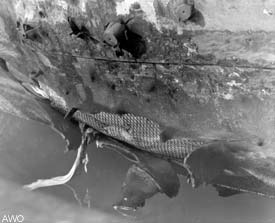
Damage control teams battle fires and repair flight deck damage.
History:
Prewar -
1941 -
1942 -
1943 -
1944 -
1945 -
Postwar
The Ship -
All Hands -
Decorations -
Remembrance
Page 3 of 3 < Previous 1 | 2 | 3
Just two minutes after the first hit, a third bomb slammed into Enterprise's flight deck, just forward of the number 2 elevator. A smaller, 500 lb., bomb, this one was defective: still, it punched a ten foot hole through the flight deck, disabling the No. 2 elevator, killing and wounding more men.
 Damage control teams battle fires and repair flight deck damage. |
As the assault tailed off, Enterprise - on fire, listing, spilling black smoke over the water - kept her place in the task force. Within an hour, the damage control parties had brought the fires under control, patched over the hole blown in the flight deck by the third bomb, counterflooded to correct the ship's starboard list, and improvised plugs for the waterline holes with lumber and mattresses. While the Wildcats overhead harassed the departing Japanese bombers, Enterprise's returning scouts circled, waiting anxiously for an opportunity to land, some breaking off to lend the CAP a hand. Enterprise signaled the task force that she could continue unassisted, and as evening came on began recovering her planes, still making 24 knots despite her extensive injuries.
An hour before the Vals had begun their attack, the Japanese commander Chuichi Nagumo, assuming the sacrifice of Ryujo had drawn off the American planes, had launched a second strike. These planes now probed the Pacific, seeking the American ships. They were just appearing on task force radar when Enterprise lost steering control.
Below decks, the steering room had been effectively sealed off immediately after the first bomb hit, to prevent the small compartment and its crew of seven from being overwhelmed by thick smoke. Between the fires encircling the compartment, and the heat generated by the powerful electric steering motors inside, the temperature inside the compartment rose steadily, from 120 degrees to 150, and then to 170. Both men and machinery failed. Enterprise's rudder swung right, swung left, swung right again and 1850, jammed hard over.
While radar now showed the incoming strike at fifty miles, Enterprise narrowly missed slicing the destroyer Balch in two. Her four great bronze screws were thrown in reverse, pulling her speed down to ten knots, as a breakdown flag was run up her truck. The rudder was jammed so far over that not even going forward on the starboard screws and reversing the port could straighten her course. She circled helplessly, an easy target for bombers and submarines alike.
An anxious thirty-eight minutes passed while damage control teams and engineers fought their way into the steering compartment, first pulling to safety the men collapsed inside, and then starting the second of the two steering motors. On radar, the Japanese squadrons passed fifty miles south of the task force, reversed course to the northwest, and missed the ships entirely. With night coming on, Enterprise had survived to fight another day.
 Bomb damage to the Big E's thin hull. Note wire mesh and bedding using to patch large hole, and wooden plugs in the smaller holes. |
Despite the severe damage Enterprise received, the Eastern Solomons were an American victory, tactically and strategically. Yamamoto's Operation KA had cost the Japanese the light carrier Ryujo. Worse, 71 planes and their aircrews from Shokaku and Zuikaku had been lost - over a hundred experienced airmen that the Japanese would never be able to replace. In comparison, fewer than 20 planes were lost between Enterprise and Saratoga. The human cost on Enterprise, however, was grim. For 74 men the attack of the 24th marked the last 45 minutes of their lives, and 91 others were wounded.
On the 25th, Yamamoto cancelled Operation KA: the first major Japanese attempt to recapture Guadalcanal had failed. That same same day, Enterprise departed for Pearl Harbor, where repair crews worked on her 24 hours a day, from September 10 until October 16. When she reappeared off New Caledonia on October 23, the situation on Guadalcanal, and in the South Pacific, had reached the point of crisis.
Image Library -
Action Reports and Logs -
News Stories
Message Boards -
Bookstore -
Enterprise CV-6 Association
Copyright © 1998-2003 Joel Shepherd ([email protected])
Sources and Credits